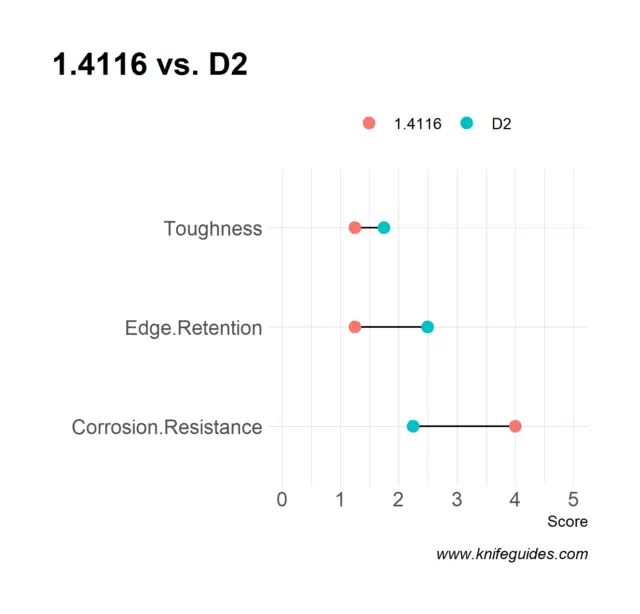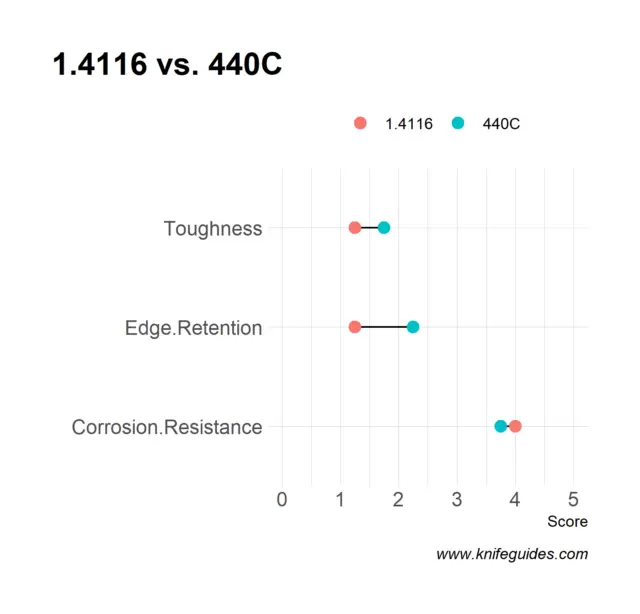(This site is reader-supported. When you buy something using retail links on our articles, we may earn a small commission. As an Amazon Associate I earn from qualifying purchases.)
If you have ever searched for German knives, chances are high for you to spot knives with 1.4116 steel. Yes, it is a popular steel variant, but its use is not limited to making knives. Today, many esteemed knife brands are using it for making kitchen and tactical knives. There must be some good reasons for that. So, let’s find out more.
What is 1.4116 Steel?

1.4116, also known as 4116, is a low-end, fine-grained, martensitic stainless steel made by ThyssenKrupp, a German company. Thus, it is also known as 1.4116 Krupp stainless steel. The German 1.4116 steel was first formulated to make knives for the medical, food, and pharmaceutical industries.
This martensitic steel is quenched at the time of its hardening process. Therefore, although you may find many claims, this steel is not a type of high-carbon steel. Instead, it belongs to the moderate-carbon steel category.
As 1.4116 knife steel is reasonably versatile, it has resulted in some confusion among its users. As many knife makers use it to provide some of their most inexpensive knives, many users believe it to be a low-quality variant. Nevertheless, esteemed German knife makers use this steel to offer entry-level and upscale kitchen knives. Thus, it is somewhat difficult to position it on a specific level of versatility.
Some users even believe that the exact composition of 1.4116 is a trade secret, due to which its construction is more difficult to evaluate. However, this is not true. It was devised for use in medical equipment, which says that its formulation has been done as per the standards. In terms of quality, it is usually compared to 440C, which should give you a hint regarding its reliable build.
The German 1.4116 stainless steel is used for making medical-grade devices and food tools, including knives such as tactical and kitchen. Today, top knife makers such as Cold Steel widely use it for making kitchen knives.
Chemical Composition
The composition of the German 1.4116 stainless steel is quite similar to X50CrMoV15. The only difference is sulfur and vanadium, with sulfur being more and vanadium being relatively less in 1.4116. Following are its components:
- 0.5% Carbon: For improved hardness as well as the ability to keep wear or corrosion away
- 15% Chromium: For the good ability to retain an edge, superb tensile strength, and more power to keep wear as well as corrosion at bay
- 1% Manganese: For more hardness
- 1% Silicon: For more strength
- 0.8% Molybdenum: For more strength as well as machinability
- 0.15% Vanadium: For better wear resistance as well as hardenability
- 0.03% Sulfur: For a more flexible manufacturing process
- 0.04% Phosphorus: For more strength
Hardness
On the hardness Rockwell scale, 1.4116 German stainless steel has a rating of 56 HRC. This makes it not too hard steel. Nevertheless, this rating can be even 55, depending on the heat treatment of the manufacturer. Still, this is a good hardness level, as many chef knives have the same hardness rating. This indicates that this steel is sufficiently hard to last long despite frequent kitchen use.
The rating of 56 HRC is due to the 0.5% carbon content. It is hard enough to cut any food items. Simultaneously, it is not so hard to chip.
Steel Properties
The chemical composition of 1.4116 determines its properties. Due to a good balance of carbon and chromium, it is exceptionally well at resisting corrosion, retaining a sharp edge, and being stronger than other competitive steels. Following are its properties:
- Great Corrosion Resistance: This is the best property of 1.4116 Krupp steel. Due to its 15% chromium content, it belongs to the stainless-steel category. This means it will not easily corrode or rust when used in saltwater or a humid area. After all, this property should not be surprising, as the steel was developed initially for medical tools.
- Toughness: Due to a high level of chromium, 1.4116 has a high level of toughness. Another reason for its toughness is the low level of hardness on the Rockwell chart. Although not the toughest steel, it can still defend itself from the harsh elements. The tougher the steel, the less hard it is! There is also enough molybdenum to deliver sufficient strength, which is required at high temperatures and to keep brittleness away.
- Good Edge Retention: This steel retains a sharp edge due to the carbon content. Indeed, it will not retain its edge shape as well as sharpness for a very long time. This is unlike what many low-end steel variants are offering. However, the widespread use of this steel for making kitchen knives proves otherwise. This steel can hold up well when used regularly in the kitchen.
- Reliable Wear Resistance: You can expect to get a durable knife due to a good amount of vanadium. It is resistant to abrasion damage, so it will not wear quickly.
- Ease of Sharpening: The German 1.4116 stainless steel is easy to sharpen, as it is a kind of soft steel due to the hardness level of below 60 HRC. This reimburses for the not-so-good ability to retain an edge. In other words, you can easily obtain an ultra-sharp edge that becomes dull. You can easily and quickly gain this edge using a standard sharpening tool.
4116 vs. Other Knife Steel Options
Comparing this German steel with other steel variants will give you an idea of how better it can perform. So, let’s compare!
1.4116 vs. D2
The latter steel is a semi-stainless option admired for its wear resistance. It is better at edge retention and toughness compared to this German steel. Nevertheless, D2 is not a type of stainless steel and1.4116 wins over when it comes to rust resistance.
1.4116 vs. 4110
The latter is also a kind of German steel, and it comes from the same company that makes 1.4116. Well, this is not surprising, considering that their names are similar. Nevertheless, information regarding 4110 seems to be insufficient.
Both the steels have similar compositions, due to which they are always compared. However, 1.4116 has somewhat more molybdenum, which means more toughness and durability.
1.4116 vs. 440C
The latter is a mid-range option with superb corrosion resistance, great toughness, and incredible wear resistance, yet has a similar performance in corrosion resistance. In addition, higher molybdenum content helps 440C for being tougher and less brittle. Yet 440C beats the German steel in edge retention as well.
1.4116 vs. 8Cr13MoV
8Cr13MoV is an affordable Chinese stainless steel. It beats 1.4116 in toughness and edge retention but loses in corrosion resistance.
1.4116 vs. 1095
1095, popular carbon blade steel rusts very easily and scores the lowest in our rankings for corrosion resistance. As expected it beats 1.4116 in toughness but loses to the German steel in edge retention.
1.4116 vs. AUS-8
AUS8(Aichi) is a mid-range performance stainless steel from Japan. In sharpening ease and corrosion resistance the German steel performs better whereas in edge retention and toughness the Japanese steel wins.
So, is 4116 a Good Knife Steel?
Yes, it is good knife steel considering its great ability to keep corrosion and wear at bay, great toughness, and ease of sharpening. Although its ability to retain a sharp edge is not the best out there, you can still rely on this German steel for kitchen tasks.

Hi, I am Jay. I am the creator of Knife Guides, your one-stop site for everything related to knives. I am a computer engineer by profession, knife aficionado by passion. Here I work with a group of people who’ve always had a passion for knives and blades. Over the years we’ve kind of become experts and decided to share our knowledge and ideas. I am also an avid hiker and enjoy offshore gamefishing.






